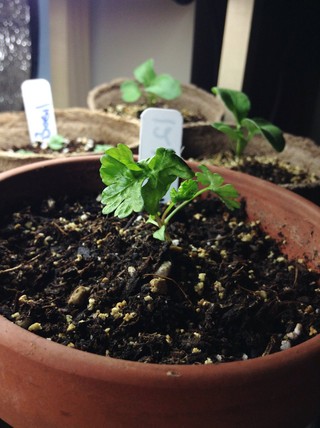How to grow parsley indoors

Over the years, parsley has been promoted from the lowly position on the corner of plates to top-rated fodder for green juices. Whether you see it as a frilly garnish or worthy of top-billing, one thing is for sure: parsley punches above its weight in flavor and health benefits. If you have a hankering to grow this classic italian herb indoors, then you’re in luck. While not an entry-level herb (it can be a little tricky to start), with a little know-how and some perseverance, you should be able to grow a tasty, abundant crop of parsley year-round.
History of parsley
Native to the Mediterranean, parsley has such a long and storied history that it is impossible to pinpoint precisely where it was first used. What is known is that ancient Greeks fashioned it into crowns to honor victorious sportsmen at the Isthmian games and wound it into wreaths to lay upon Grecian graves.[1] Its ceremonial and medicinal applications predate its culinary use, but once it was imported to France from Italy by Catherine de Medici, that changed dramatically.
Curly leaf vs Flat leaf
Curly leaf parsley
The classic focus on curly parsley is primarily as a garnish, but also has other uses. Generally speaking, when a recipe calls for parsley the Italian flat-leaf variety is more commonly used.
Flat leaf parsley(Italian Parsley)
The fresh, pungent flavors it lends to stews, marinades, salads, and sauces more than proves parsley’s value as a key ingredient.
Truthfully, it’s hard to find any savory dish that doesn’t benefit from a smattering of parsley. These days, you’ll find it not only in food, but in beverages, too. Parsley regularly shows up in the ingredients of green drinks, touted for its antioxidant and nutrient-dense properties.
Medicinal applications
This unassuming herb does more than just a add pizzazz to pizzas and frittatas– long before it made it to the dinner plate, it was in the medicine cabinet. Hippocrates, the “Father of Medicine” was fond of prescribing parsley root to relieve kidney and bladder ailments, and parsley was used in ancient times to treat bronchitis, digestive disorders, and more.
As it turns out, parsley lives up to the hype. Modern science has isolated a parsley compound called apiol that is effective in treating kidney stones and urinary disorders. Another compound, called apigenin, may help to reduce cancerous tumors.[2] What’s more, the green-juice market is right to promote the power of parsley: rich in antioxidants, vitamins A and C, and antihistamines, it reduces inflammation and helps the body fight off infection. Basically, you want parsley around, which brings us to our next section.

Flat-leaf parsley. Image: psychodelicacy
Growing parsley indoors
Growing conditions
Flat-leaf parsley is a perfect plant to grow in containers and indoor herb gardens, thanks to its hardiness. The Latin name of parsley, Petroselinum crispum, comes from the Greek word for stone– based on the rocky outcroppings where it preferred to grow. This should give you some idea of the conditions flat-leaf parsley thrives under: full sunlight, and lots of it, at least 5-8 hours per day.
Difficulty level
Parsley is an intermediate-level herb to grow, if only because of its exceptionally long germination period. It can take parsley seeds several weeks to sprout, which was why farmers were superstitious about it in ancient times: they believed the seeds had to travel to hell and back seven times before they could grow![3] Some refused to grow it at all, which was their loss.
Light requirements
If you have a sunny window sill with southern exposure, that should be perfectly sufficient full sun light in the summer months. In the winter, you will need supplemental light no matter what. If you need a little help achieving optimal light levels, no worries. A full-spectrum LED panel grow light will bathe your parsley in the right type and amount of light it needs. For best results, suspend lights just over the surface of the plant and raise the light as the plants grow. This ensures healthy, dense growth.
Container and soil type
Find a container that is both wide and deep enough to keep your plants happy. A long window box planter is an ideal choice, as it should give you enough space to plant between 4 and 6 plants (enough for an ample supply of fresh parsley).
Parsley plants grow best with 6 inches of space between them. Rectangular window box-type planters also typically come with trays that fit beneath them– critical for keeping overflow water off your window sills or table tops.
The best soil to grow parsley is a potting mix for vegetables. In lieu of that, find a potting mix that is light and contains a mix including perlite or vermiculite, coir or peat moss, and compost. To learn more about the ideal indoor potting soil read our full guide.
Never pack your soil too tightly into a pot, just press it gently into the pot slightly moist and pat it down. Don’t be afraid to fill the pot almost to the top– water the pot thoroughly outside using a watering can or a hose with a spray attachment and the soil will settle as the water drains. Starting with uniformly moist soil will help encourage healthy root growth.
Germination and temperature
To shorten germination time, you can soak your seeds overnight or for up to 3 days. Parsley is quite forgiving and will germinate between 50 and 85 degrees, which coincides perfectly with indoor temperature ranges. Sow your seeds no more than a quarter of an inch deep, and sow more than one in each area– if more than one germinates, pull all but the strongest one. Be patient, and keep the soil surface moist but not wet. Once your seeds have sprouted, just ensure that they have sufficient light and that the soil remains moist as they develop. The temperature inside your home should be just right to encourage growth.
Basic care
As mentioned before, make sure that your growing seedlings have sufficient light to thrive. Place planters on south-facing window sills, and in the winter supplemental LED and grow lights. Take care to water your container as soon as the top couple of inches are dry.
If you’re able to, the very best way to water plants in pots is from below. To do this, you will place your container in a larger container and fill the larger container with a few inches of water and then wait until the water has completely absorbed into your plant container. This ensures that the soil is uniformly moist to the bottom, and will encourage your parsley to grow deep roots.
Harvesting
As with most of the herbs we discuss here, parsley is best harvested before it is fully bloomed. We recommend starting with the outer leaves and gently working your way into the center of your parsley plant. Take care in maintaining the structural integrity of the plant as you want your parsley plants to be able to produce new growth in the future.

The enthusiast's guide to herbs
We’re proud to present our new e-book, The Enthusiast’s Guide to Herbs! Learn everything you need to know about growing and caring for herbs indoors, including in-depth info cards for the 35 most commonly grown herbs.
Click the link below to find out more!
Storage
After harvesting your curly or flat-leaf parsley, its time to consider your options for use and storage. For long term use, we suggest thoroughly drying your herbs by using the method of your choice. Check out our how to dry your herbs guide to learn more.
While drying your herbs is a great long term storage option, many find using fresh herbs to be a more flavorful experience. Learn more about unique methods to preserve fresh herbs here.
Suitability as a microgreen
Parsley makes for a fantastic microgreen. You may have seen microgreens on high-dollar dishes used as a garnish, but they offer many more benefits than flavor. Unlike full-grown plants, microgreens can be grown and harvested in weeks rather than months.
Supplies
- Shallow growing trays, with or without dome lids
- Potting soil or soilless growing medium
- Spray bottle
- Artificial lighting
How to grow microgreen parsley
- Fill your trays with a seed-starting medium to around a half inch from the top.
- Scatter your pre-soaked seeds over the starting medium as evenly as possible.
- Cover the seeds with a very light layer of planting medium, and spray the surface thoroughly until it is uniformly moist.
- Once the seeds are sprouting, uncover the tray (if you’ve covered it) and place it in a location where it receives adequate ventilation.
- Water daily with the spray bottle, but never saturate soil. Overwatering– especially curly-leaf parsley– can doom seedlings to failure.
- After a couple of weeks, when the first true leaves emerge, your microgreens are ready to harvest. Cut everything but the bottom of the stem with scissors and use as soon as possible. If you must store parsley microgreens, place the cut stems in a small glass with a half inch of water in it–like you would cut flowers– and use them as quickly as you can.
Conclusion
Growing herbs indoors is a fun, satisfying way of dabbling in gardening, increasing your intake of nutrients, and widening your culinary palette. Parsley isn’t the easiest herb to start with, but it is an incredibly rewarding culinary herb and microgreen.

Join our email club—get printable info cards free!
Sign up to receive our newsletter and get access to 10 printable plant info cards from our e-book for free. Also receive:
- $4 discount code for our Guide to Herbs e-book
- Semi-weekly plant inspiration & bite-size tips and tricks
